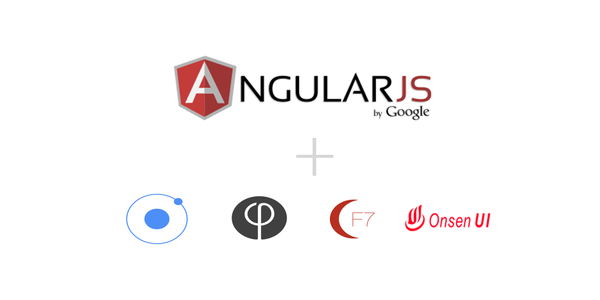
For those developers who were stuck to traditional frameworks and platforms,the continuously growing demand for hybrid mobile apps serves as a motivational factor. It is absolutely possible (and feasible) to build hybrid apps using a framework that integrates well with Angular JS.
Four of the simplest yet stunning UI frameworks are Ionic, F7, Famo.us and Onsen UI.
Let’s discuss each of these frameworks individually so that you are clear about what framework would fit your hybrid app development requirements effectively.

The ionic framework:
This is an open source hybrid UI framework and offers a wide library of mobile optimized HTML, CSS and JSS components. Moreover there are lots of cool features like unique gestures and tools that allow you to build interactive mobile apps. Ionic framework is built using SaaS and Angular JS, therefore it is a simple option for quickly building a beautiful looking hybrid app.
Merits of ionic
- It comes with tabs, lists, header bars and cards
- You enjoy optimum convenience in overriding the styles via CSS
- Via a single command, you can create, build test and deploy apps onto any desired platform thanks to a powerful CLI
- To get started with ionic framework, all you need to know is HTML, CSS and Javascript.
Demerits of iconic
- Debugging AngularJS is time and effort intensive
- Getting the right app navigation is quite difficult
- Native apps are much more smoother than ionic apps
- Very few animations

The F7 framework:
This HTML mobile framework allows one to develop web or hybrid mobile applications which depict the same “look and feel” of native iOS and Android applications.
Moreover, Framework 7 allows one to create app prototypes that can be shown to the client when the requirement arises. It is focussed on Google’s material design and iOS and enables developers to build simple and user friendly mobile applications.
Merits of F7
- F7 empowers you with ready to use UI elements and widgets such as : popover, modals, side panels, preloader, action sheets etc.
- Customization is very easy
- There are some cool features to be found such as Swipe Back, Dynamic Navbar, Swipe actions, Messages etc.
Demerits of F7
- It may not be compatible with all the mobile platforms
- One must use the built-in F7 MVC framework to get started with mobile app development using F7
- A tedious but mandatory process is added as the lack of basic template expects you to create a new basic HTML file.

The Famo.us framework
This open source, free JavaScript framework allows you to create complex UIs that fit every type of screen. It abstracts DOM and WebGL, enabling one to do custom layout and delivering in the best possible way.
You can centre and rotate objects with just a few lines of code. Famo.us is backed by a completely rebuilt architecture and comes with transforms that are entirely updated through an inbuilt event system- which prevents unwanted matrix multiplications.
Merits of Famo.us
- Building high performance mobile apps is guaranteed as it creates it’s own DOM rendering tree.
- Developers new to the world of hybrid app development get help with a starter kit.
- It is devoid of any third party dependencies and is 80% fastest compiled C
- Developers can build complex animations, using the 3D animation engine.
Demerits of Famo.us
- Non-performant CSS- You must twist CSS for breaking the bounding box, combining border-radius and box-shadow and transitioning color values. This causes performance issues.
- Browser specific issues can occur: such as a combination of overflow: hidden and CSS will transform into Z spaces. Moreover, the intersecting surfaces in Firefox and Google Chrome don’t render appropriately

The Onsen UI framework
Onsen Ui comes off as a handy option for PhoneGap and Cordova developers as it is a custom elements based HTML 5 UI framework. Coming with multi screen support, this fully responsive framework’s view adjusts on the basis of screen size and can be used conveniently with the use of <ons-split-view> tag.
A sit serves an open source framework, it also offers you an excellent alternative for deploying applications to the server. As you do this, you can use the app as a tool for building a high performance website.
Merits of OnesenUI
- It is an easy to use framework as it is inspired by web components.
- It is highly compatible with both jQuery and AngularJS
- It comes loaded with features including built in Theme Roller, Screen Transition, Font awesome and many more.
- It is free and open source
Demerits of OnesenUI
- The “Getting started” guide is pretty unclear
- The templates built using Onsen UI framework are not hosted in a reputed repository like GitHub. Therefore you must download these templates in order to use them.
- In case you have to update your website with a template upgrade, it becomes a daunting task
Concluding words
Settling down for the best one can turn to be difficult decision when all the aforementioned frameworks wish to achieve the target of providing a native-like UI framework for creation of hybrid mobile apps.
However, we believe that the set of details covered here would aid you in choosing a framework that addresses your hybrid app development needs in the most appropriate way.




